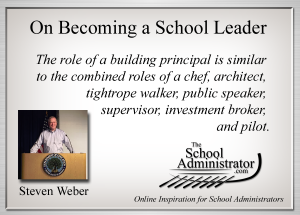(Originally posted on ASCD EDge)
By Steven Weber
School leadership has changed over the past twenty years. The role of a building principal is similar to the combined roles of a chef, architect, tightrope walker, public speaker, supervisor, investment broker, and pilot.
As a chef, the school leader stirs the right ingredients and takes risks, adding some original ingredients in order to support teaching and learning.
As an architect, the school leader uses the standards as a blueprint. While the standards provide a blueprint, the principal still needs to identify the school’s vision. The architect looks for weaknesses in the foundation and seeks appropriate action in order to support the entire building.
As a tight rope walker, the principal must balance state board mandates, state and federal legislation, local school board policies, the requests of stakeholders, the needs of students, and the school district’s initiatives. Walking the tightrope is an art and an outstanding principal demonstrates balance.
As a public speaker, the school leader must speak like Dr. Martin Luther King, Jr. When the principal speaks to families, the message must be intentional. Speaking to the staff provides the principal with an opportunity to influence teaching and learning. A public presentation to the Board of Education is another way that the building leader can advocate for his or her school. Public speaking is no longer an option for school leaders.
As a supervisor, the school leader visits classrooms and provides feedback on teaching and learning. The school leader must demonstrate effective communication skills and must use this role to support teachers. Teachers need to grow and supervision provides the principal with an opportunity to help each teacher reflect on the whole child and the needs of each student. Supervision is not a responsibility to be taken lightly.
As an investment broker, the school leader is investing in the future. The return on the investment may not be seen for twenty years, but the investment is important. Should the principal use school funds for an extra reading tutor? Should the school purchase an app to increase communication with families? Is it worth the money to purchase iPads for every fourth grader? When a principal is able to make critical decisions using the taxpayers’ money or PTA funds, then he or she is making investment decisions.
As a pilot, the school leader is taking the school to new heights. The takeoff is critically important, but a safe landing at the end of the school year is also worth noting. Did the school staff take students to a new location, or did they spend the entire year on the runway? While in flight, the principal must monitor teaching and learning and make adjustments. If students are off course, the principal must work with teachers and school staff to redirect the plane and help all students prepare for their final destination.
Are you considering becoming a school leader? It’s not as easy as it looks. Excellent school leaders demonstrate the same skills as leaders in other fields. “Leaders must wake people out of inertia. They must get people excited about something they’ve never seen before, something that does not yet exist” (Rosabeth Moss Kanter). Do you have what it takes?



No Comments Yet